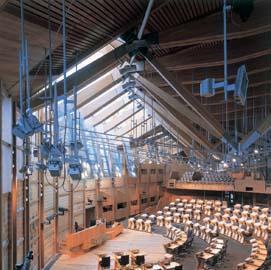It is easy for designers to pay lip service to sustainability. Now an accreditation scheme for Scottish architects will ensure those making such claims are qualified to do so.
Green. Sustainable. Environmentally friendly. Low energy. Architects and engineers frequently label their schemes with epithets such as these. But what do these expressions mean? In a majority of cases nothing, sadly, because the architects making the claim is often the least qualified to make such a declaration. “It is easy for architects to pay lip service to sustainability,” says John Kinsley, an associate architect at RMJM’s Edinburgh office.
Now, all this is about to change. On 1 February, at the recently opened Scottish Parliament building, the Royal Incorporation of Architects in Scotland (RIAS) was due to launch an accreditation scheme in sustainable design – the first ever such scheme.
The scheme is being introduced to endorse architects with a proven ability as a sustainable designer. “I was fed up with people saying they do sustainable design after they’ve done a two-hour course or a two-day course,” says professor Sandy Halliday, head of Gaia Research, and the person who initiated and developed the scheme.
According to Halliday, accreditation recognises four levels of skill in sustainable design, based on the complexity of completed projects. To be eligible, an individual must provide evidence a design has addressed issues such as resource use, pollution, supporting communities, biodiversity, healthy environments and managing the build process. Assessment is by peer review with qualified assessors. “It is a process of aspiration; you start on small buildings and advance to larger schemes with multidisciplinary working,” she says.
Green practitioners have given the scheme their backing. “Accreditation is an accurate measurement of people’s commitment and experience in sustainable design,” says Chris Morgan, principal of Edinburgh-based Locate Architects and one of the first architects to be accredited. He says the scheme will provide official recognition of green design as a specialist skill through the assessment of completed projects. “If you want to do a very good sustainable development it is a very complex process and co-ordinating the various elements is a difficult and skilled process,” he explains
Sebastian Tombs, chief executive of the RIAS, says accreditation will ensure architects contribute in the most effective way to the sustainable agenda. “Sustainable building design is a huge field. Our concern, as building designers, is to find ways that our particular dimension of the sustainability agenda can be addressed,” he says. According to Tombs, the key to the scheme is applied knowledge, with actual projects used as evidence of an architect’s ability. “BREEAM assesses a building’s performance, this scheme assesses how well a professional is performing,” he says.
RMJM’s Kinsley will be applying for accreditation based his contribution to the design of the Scottish Parliament building. He says it will give RMJM a competitive edge pitching for work. “Accreditation will demonstrate an ability our competitors won’t necessarily have,” he says.
The accreditation scheme is unlikely to become nationally recognised because the RIBA fails to see a need for it. A spokesperson for the RIBA said: “It is a requirement all our members design in sustainable manner – it is a major part of architectural training – so there are no plans to introduce accreditation”.
But what about other disciplines? Halliday says she always intended the idea of an accreditation in sustainability to be applicable to all of construction. “It was always my intention that organisations such as CIBSE adopt the scheme,” she says. However, Such a move appears unlikely. Samantha McDonough, policy director at CIBSE, says “It is likely the Council’s view will be that environmental issues are already covered by the Institution’s code of conduct, which requires members to have due regard to environmental issues”.
The Carbon Task Group, however, is considering less formal scheme by creating a database of case studies on buildings that go beyond basic regulatory requirements for clients to see where services engineers have made a contribution to sustainability.
Source
Building Sustainable Design





















No comments yet